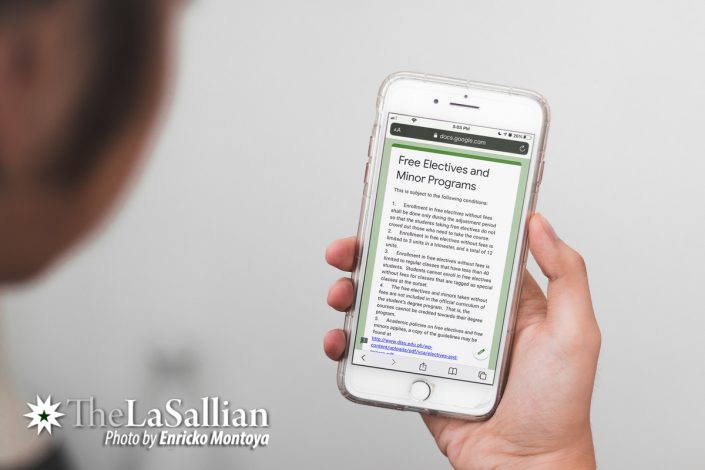
“Real-world problems more often than not require a multi-disciplinal approach.”
This was what the Academics Council (AC) wrote on May 18 of last year when it approved guidelines for free minors programs and free electives and recognized the need for students to explore areas of discipline outside of their degree program. What followed a month later were additional provisions that allowed undergraduate students to take 12 units of free electives or minor courses—free of charge, as Vice Chancellor for Academics (VCA) Dr. Robert Roleda once proclaimed to The LaSallian.
Three terms have passed since then, and the list of available programs and electives have expanded. This opportunity also allowed students to immerse themselves with fellow students belonging from another college.
Recalling the initial plan
The availability of free minor degree programs and electives were announced mainly through Help Desk announcements before the beginning of the term. Interested students must submit an application to the department but must also be aware if the academic department might be requiring additional requirements, as former College of Liberal Arts (CLA) Dean Dr. Jazmin Llana once mentioned during an interview with The LaSallian last year. Successful applicants are also subjected to follow the guidelines provided by the AC.
To enroll in their preferred classes, students would need to fill out the Google Form within the adjustment period. The Academic Programming Officer (APO) would then use this information to manually enroll students in the class. Roleda explained that this rule was created to avoid incidents where students who need to take certain courses as part of their flowchart are crowded out of the class.
“The difference between enrolling through Animo.sys and through Google Forms is that when you enlist through Animo.sys, you have to pay for it; and when you apply through Google Forms, you have to wait for the APO to enlist you to that class, so it could be counted as free,” explains Britney Paderes (II, AB-POM), who is completing a minor degree in Economics. Andrew Chen (III, MEE), who is currently taking a minor degree in Accountancy, says that enrolling through Google Forms was still “not perfect” due to the process of enrolling a free minor during the first week of a term. The time between enrolling through Animo.sys and Google Forms is significantly distinct; it takes about a week for the University Registrar to process the students with minor degrees’ requests, leaving students clueless as to whether they have been enrolled into the class or not, he elaborates.
Paderes suggests that enrollment should be held during the adjustment period for students to easily catch up with the lessons. Meanwhile, Noki Topacio (IV, BS-CS), another Economics minor degree taker, suggests creating a platform for students taking the same program to coordinate and learn from each other.
Chen also believes that orientations for minor degree takers should be conducted. College of Liberal Arts Associate Dean Dr. Ron Resureccion had already stated that some departments hold orientations while some do not. This implies the need for orientations in some departments to guide students when enrolling for their desired free minor degree.
The current enrollment process
How the APO approaches applications for minors is quite different from their initial plan due to online classes implemented before they could allow applications being done manually. Students are required to apply through Google Forms if they decide to get a free minor or elective.
Resurreccion shared his thoughts and justifications on the capability of the APO filtering requests. With the influx of enrollments, the “challenging period” happens during the first two to three weeks of classes for regular students since this is when the APO comes in to tend to students enrolling their classes for their minors.
Resurreccion explains that during the enrollment period, the first priority are students who need to follow their flowchart. Students who applied for a free minor but enrolled during regular enrollment will be required to pay for their classes rather than attend it for free. Students who intend to take their minors for free will be handled during the adjustment period, which is also the time when students who enrolled late are handled.
“Puwede ka lang mag-take ng free minor kapag hindi siya part ng flowchart mo,” he clarifies, “pero ang goal ng free minor kailangan ma-kompleto mo ‘yun for 12 units or 15, depende kung gaano kadami units ng minor program para ma-earn mo yung minor degree.”
(You can only take a free minor degree if it’s not part of your flowchart, but the goal of a free minor is that you should complete 12 or 15 units, depending on how many units the minor program requires so you can earn your minor degree.)
In a Help Desk Announcement last June 1, it was announced that students with minor degrees are counted as shiftees for record-keeping purposes to categorize students who have minor degrees and students with none. However, they are not required to apply for regular shifting. There is a form required to be accomplished, in this way, they would not need to go through the regular shifting procedure.
